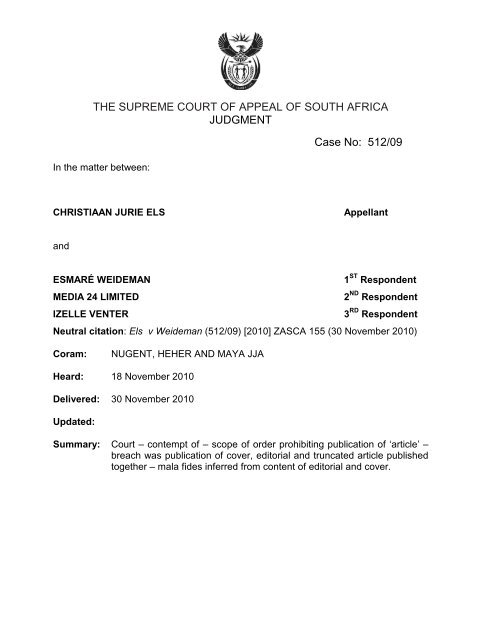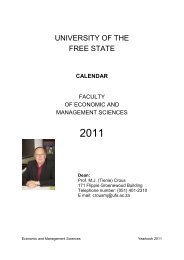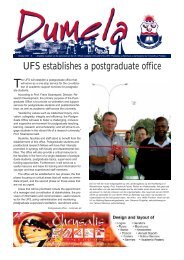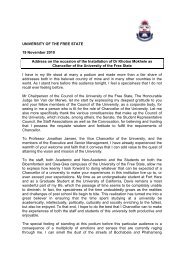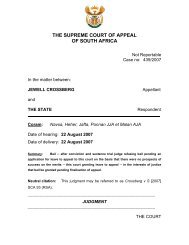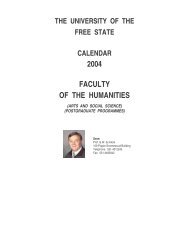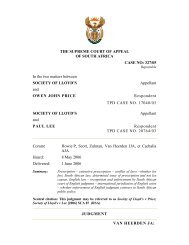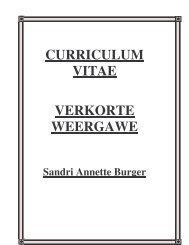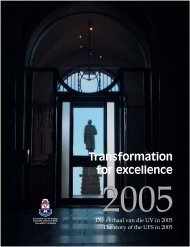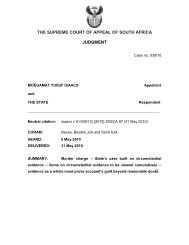THE SUPREME COURT OF APPEAL OF SOUTH AFRICA ...
THE SUPREME COURT OF APPEAL OF SOUTH AFRICA ...
THE SUPREME COURT OF APPEAL OF SOUTH AFRICA ...
Create successful ePaper yourself
Turn your PDF publications into a flip-book with our unique Google optimized e-Paper software.
<strong>THE</strong> <strong>SUPREME</strong> <strong>COURT</strong> <strong>OF</strong> <strong>APPEAL</strong> <strong>OF</strong> <strong>SOUTH</strong> <strong>AFRICA</strong>JUDGMENTIn the matter between:Case No: 512/09CHRISTIAAN JURIE ELSAppellantandESMARÉ WEIDEMAN1 ST RespondentMEDIA 24 LIMITED2 ND RespondentIZELLE VENTER3 RD RespondentNeutral citation: Els v Weideman (512/09) [2010] ZASCA 155 (30 November 2010)Coram:NUGENT, HEHER AND MAYA JJAHeard: 18 November 2010Delivered: 30 November 2010Updated:Summary: Court – contempt of – scope of order prohibiting publication of ‘article’ –breach was publication of cover, editorial and truncated article publishedtogether – mala fides inferred from content of editorial and cover.
3entertainment world. He emigrated to New Zealand and was living there in February andMarch 2008 when the events giving rise to this appeal took place.[4] Huisgenoot and You are magazines edited by the first respondent, Ms Weideman,and owned and published by the second respondent, Media 24 Limited. They areAfrikaans and English versions of the same magazine. The third respondent, Ms Venter,was the editorial head of the Johannesburg office of the magazines.[5] In setting out the chronology that follows, I make extensive use of the versiondeposed to by the respondents in the contempt proceedings almost all of which iscommon cause.[6] On Monday 11 February 2008 the Beeld newspaper published an article stating thatone Robbie Klay, whom it described as a 21 year old singer and actor, had been, over aperiod of seven years, the ‘sex toy’ (‘seksspeelding’) of one of the best known men in theSouth African entertainment world. The article did not identify the man, saying Klay did notwant the name to become known because that would ruin the man’s life. According to thearticle Klay had disclosed the name to Beeld, but in the article the man was referred tosimply as ‘die oom’ (ie a respected older man).[7] The article contained detailed allegations by Klay relating to the abuse he hadsuffered at the hands of this man and explained that Klay had kept silent about the abusebecause he had feared that his own career would suffer as the man possessed power inthe entertainment industry. The article concluded by saying that all attempts by Beeld tocontact ‘die oom’ the previous day had been unsuccessful: his cell phone was switched offand several people suspected he was overseas.[8] At 11h16 (22h16 New Zealand time) on 11 February 2008, Ms Marie Opperman, ajournalist who wrote for Media 24’s magazines and had previously written articles aboutEls’s marriage and the birth of his daughter, sent an e-mail to him, attaching an Englishversion of the Beeld article. Opperman said that it was alleged that Klay had said, off therecord, that Els was the man he was referring to. She said Huisgenoot was sending
4someone to interview Klay. She asked Els to comment, saying the deadline for the articlewas the next evening.[9] Over the following two days Opperman sent four further e-mails bearing a similarimport. Most distastefully, she also pressured the appellant to persuade his wife, a personwell-known in South Africa in her own name, to comment on the allegations. Oppermanalso contacted the appellant’s sister who informed her that she had earlier been told bythe appellant that he was busy with an answer to her e-mails.[10] Els replied to Opperman’s last e-mail at 22h58 on 12 February 2008 (09h58 onWednesday 13 February New Zealand time):‘Stuur asb vir my die storie. Ek en my prokureur is tans aan die gesels daaroor en ek sal antwoordsodra ek die storie gekry het.Terloops: Ek kruip nie weg nie maar ek het niks om weg te steek nie en daarom wil ek niekommentaar lewer nie. Ek sal beslis ‘n naamskending saak maak sodra my onskuld bewys is,daarvan kan Robbie en Huisgenoot seker wees.’[11] At about 10h00 on 13 February Els’s South African attorney contacted the office ofthe publisher of family magazines at Media 24. In the result an undertaking was given tosend a copy of the article to the attorney.[12] At 12h01 (23h01 New Zealand time) on 13 February the draft article was sent to Elsand attorney du Plessis by the third respondent who also notified du Plessis that she haddone so. As indicated in the Opperman e-mails, the article was based on and quoteddetailed allegations by Klay that Els had sexually molested him from the age of 10 years.[13] At 12h38 (23h38 New Zealand time) on the same day Els sent an e-mail to the thirdrespondent:‘My prokureur Koos du Plessis . . . sal jou kontak aangesien ek hom en ‘n advokaat aangestel hetom hierdie saak namens my te hanteer. Maak seker jy maak kontak met hom voor julle publiseerasb want hierdie ding is groter as wat ‘n mens dalk besef en die gevolge kan ernstig wees.
5[14] Shortly before 17h00 on 13 February 2008 Els’s attorney informed Media 24’sattorney that Els intended bringing an urgent application at about 18h00 at the home ofSutherland AJ in Johannesburg. (Although Els alleges that earlier in the day his attorneysought an undertaking that the article would not be published until he had been given afair opportunity to respond to it, that allegation was denied by the second respondent’sattorney.)[15] The application comprised a notice of motion without a supporting affidavit. Therespondents were Media 24 and Venter. Sutherland AJ heard argument from Els’scounsel (who was present in person) and the respondents’ counsel (over the telephonefrom Cape Town). He granted the relief sought and furnished brief oral reasons. Later thatevening the learned judge e-mailed to the parties’ legal representatives a document whichin essence contained the terms of the order, and the following day he gave more detailedwritten reasons.[16] Sutherland AJ’s order included interim relief phrased as follows:‘An interim interdict shall issue immediately against the First and Second Respondents frompublishing the article of which a copy was annexed as “A” to the Notice of Motion, pending theinstitution of an application for final relief by the Applicant within 10 days hereof.’Annexure ‘A’ was the draft article which, earlier that day, Venter had sent to Els for hiscomments.[17] The order did not expressly prohibit publication about the proceedings beforeSutherland AJ. The fact that Els had applied for and obtained the interim interdict was,according to the respondents, widely publicized in the media.[18] On 14 February 2008 the Cape newspaper Die Burger, (also a Media 24publication) published an article which included the following:‘Huisgenoot en You se redakteur, Esmaré Weideman, het gisteraand gesê ná deeglike oorwegingis besluit om voort te gaan met die publikasie van die artikel maar om nie die sanger se identiteit teopenbaar nie.“Ons is verbaas deur die interdik, aangesien die appèlhof onlangs bepaal het die media se mond
6kan nie deur middel van ‘n interdik gesnoer word nie, omdat die opsie bestaan om ná publikasie ‘nlastereis in te dien. Nog meer verbasend is dat die interdik toegestaan is in die Witwatersrandseprovinsiale afdeling van die hooggeregshof, aangesien Media 24 se hoofkantoor in die Kaapseprovinsiale afdeling van die hooggeregshof is.In die lig daarvan dat minstens twee ander persone ná publikasie van mediaberigte na vore gekomhet om dieselfde sanger van seksuele molestering te beskuldig, ag Huisgenoot dit in openbarebelang dat ons voortgaan met die publikasie van die artikel.”’[19] The contents of the article published in Die Burger on 14 February prompted one ofEls’s attorneys to telephone Venter about the impending publication in Huisgenoot andYou and to confirm the contents of their conversation in an e-mail to Venter later that day.The e-mail included the following:‘Ons verstaan uit die artikel soos vanoggend in Die Burger gepubliseer, asook uit die gesprekhierbo na verwys, dat Huisgenoot/You ten spyte van die hofbevel van voornemens is om voort tegaan met die publikasie van ‘n “gewysigde” weergawe van die artikel.Ons plaas op rekord dat indien ons kliënt se identiteit op enige wyse afgelei kan word uitbogenoemde, u asook Media 24 hulself skuldig sal maak aan minagting van die hof en sal ons byregte wees om ‘n lasbrief vir u arrestasie uit te reik.’[20] On 21 February 2008 editions of Huisgenoot and You were published, eachcontaining matter which, Els alleges, constituted the article referred to in the order ofSutherland AJ.[21] On 25 February 2008 Els instituted contempt proceedings in the Western CapeHigh Court against Weideman, Media 24 and Venter. Although Weideman was not a partyto the proceedings in Johannesburg she had knowledge of the order and obliged tocomply with its prohibition.[22] Els identified the offending matter in each of the publications as:(a) the front cover;(b) the contents page;(c) the editorial;
(d)an article entitled ‘MY JARE in GESENSOR! se KLOUE’ (Huisgenoot) and‘CENSORED! molested me SEXUALLY’ (You);(e) a further article in the ‘advice’ section entitled ‘INSTINK WAT JOU KIND KAN RED’(Huisgenoot) and ‘HOW <strong>THE</strong> ABUSE BEGINS’ (You).7[23] Els alleged that the respondents had published the article intentionally and in badfaith. (In argument before the court a quo, as the judgment of Dlodlo J makes clear,counsel on his behalf contended in the alternative that Weideman and Media 24 had beennegligent and that negligence was sufficient to sustain their conviction of contempt of courtbecause they were, respectively, the editor and the owner of the magazines. 1 Thatcontention was repeated before us, but it is unnecessary to answer the questions that itraises.)[24] Els asked for orders convicting the three respondents of contempt of court,sentencing Weideman to imprisonment, Media 24 to a fine, and Venter to a suspendedperiod of imprisonment, and directing them to pay the costs, jointly and severally.[25] The respondents opposed the relief on grounds which included the following:(a) the Western Cape High Court did not have jurisdiction to hear the contemptapplication because the order allegedly breached had been made by the South GautengHigh Court;(b) the matter published in the 21 February editions of the magazines did not constitutethe article and its publication was not prohibited by the order on any other basis;(c) that Weideman, not Venter, took the decision to publish; and(d) Weideman did not intend to act in contempt of the order, nor did she act in badfaith.[26] On 18 March 2009 Dlodlo J delivered judgment dismissing Els’s application on thegrounds that the Western Cape High Court did not have jurisdiction to entertain anapplication in relation to alleged contempt of an order made by the South Gauteng HighCourt. For ‘academic purposes and in the event that I am found to have wrongly applied1 Relying on S v Harber 1988 (3) SA 396 (A).
8the law on the question of jurisdiction’ the learned judge proceeded to consider the meritsof the application and concluded that 1) the offending publications differed from the articleand were consequently not prohibited by the order, 2) Venter had not been involved in orresponsible for the decision to publish and could not, therefore, be convicted of contemptof court, 3) Weideman’s assertions that she did not act intentionally or mala fide could notbe rejected as so implausible as to warrant dismissal without recourse to oral evidence,which Els had not sought, and, 4) negligence had not been raised as an alternative basisfor conviction in Els’s papers. The application was, for all these reasons, the learned judgeconsidered, without merit.[27] Before us on appeal both counsel approached the matter on the basis that, if weshould find that the court a quo had indeed possessed jurisdiction to decide theapplication, we should proceed to decide the merits and not refer the matter back. Subjectto what may have to be said on the question of sanction (should the arguments for theappellant otherwise be sustained) that appears to be an appropriate course as the matterhas been fully argued in both courts.Jurisdiction[28] The issue in the appeal really involves two aspects. The first is the relationshipbetween the High Courts of this country in regard to the enforcement of an order of one ofthem. The second is whether proceedings for contempt of court arising from a breach ofan order of one High Court can be tried before another and, if so, whether the lastmentionedcourt can or should decline to exercise jurisdiction in such an application.[29] The argument before this Court was largely directed to the second aspect. Perhapsthat was because the law in relation to the first is clear and has been stated on previousoccasions by this Court. In summary-(a) a judgment and order of the Gauteng South High Court would run throughout theRepublic and would have legal effect (including enforceability) in the jurisdiction of otherHigh Courts of our country: s 26(1) of the Supreme Court Act 59 of 1959;(b) the first respondent resided in Cape Town and the second respondent had its headoffice and principal place of business in that city: the Western Cape High Court
9accordingly had jurisdiction over the persons of the first and second respondents: s 19(1)of the Act. The third respondent, who resides in Johannesburg, was subject to thejurisdiction of that Court by reason of the provisions of s 19(1)(b) of the Act;(c)the alleged breach of the order took place in Cape Town when the offending articlewas published there. The cause therefore arose within the jurisdiction of the WesternCape High Court as contemplated by s 19(1)(a).In the normal course this legislative foundation would be decisive and considerations ofconvenience and commonsense (both of which favoured the jurisdiction of the court aquo) would not need to be brought into the equation. See Estate Agents Board v Lek 1979(3) SA 1048 (A) at 1067E-G and the cases there cited. As Steyn CJ said in RobertsConstruction Co Ltd v Willcox Bros 1962 (4) SA 326 (A) at 336A:‘Ook ons Howe kan, wat hul prosedures en die ten-uitvoer-legging van hul vonnisse betref, rekenop doeltreffendheid buite hul gebied. Die dagvaardings en bevele van die een Hof kan in die gebiedvan ‘n ander bestel en afgedwing word.’Why should that salutary principle not also apply to the application to the Western CapeHigh Court in this case?[30] The respondents’ argument (which found favour with the learned judge) was thatthe particular nature of the proceedings excluded the aegis of any court but the one thatgranted the order; the applicant could in the first instance have applied in the Cape insteadof electing the jurisdiction of South Gauteng but, having made the election he was boundby law to submit such contempt as he perceived to that court. Dlodlo J was persuaded bythe following considerations:1. The South Gauteng and Western Cape High Courts are separate high courts eachwith its own area of jurisdiction (with particular reliance on s 166(c) of the constitution andschedule 16(4)(a) to it; and s 3(1) of the Rationalisation of Jurisdiction of High Courts Act41 of 2001).2. An application for committal for contempt of court has to be made to the courtwhich made the order which a respondent is said to have disobeyed. Contemptproceedings are not new proceedings but merely a continuation of proceedings previouslyinstituted: James v Lunden 1918 WLD 88.[31] I respectfully disagree with the reasoning of the learned judge.
10[32] The separate jurisdiction of courts must be understood in the light of the practicaladaptations brought about by the provisions of the Supreme Court Act and itspredecessors. As pointed out in Estate Agents Board v Lek at 1062A-C, since 1912 thejudgment or order of one division of the Supreme Court has been executable in thejurisdiction of all the others. Effectiveness is not sufficient of itself to confer jurisdiction butmay be a factor to be taken into account, in conjunction with other factors, in consideringwhether some common law ratio jurisdictionis does exist to confer jurisdiction on a HighCourt in respect of the particular proceedings. For the reasons already mentioned suchother factors are present in this case.[33] With regard to the authorities relied on by the learned judge I agree with counsel forthe appellant that they fall generally into two categories:(a) those that hold that the High Court cannot or will not exercise jurisdiction to try aquestion of contempt of the order of a lower court or one exercising an unrelatedjurisdiction: R v Chadwick (1901) 22 NLR 139 (the magistrate’s court); Clerk of the Peacev Davis (1908) 29 NLR 20 (the magistrate’s court); Komsane v Komsane 1962 (3) SA 103(C) (the so-called ‘Native Divorce Court’); Wright v St Mary’s Hospital Melmoth 1993 (2)SA 226 (D) (the Industrial Court). None of these cases was concerned with the legalrelationship between the divisions of the High Court as they presently exist;(b) the continuation of proceedings in a high court in which it was initiated and in whichan order was granted, at a time when the disobedient party has left the area of jurisdictionof that court (James v Lunden; Cats v Cats 1959 (4) SA 375 (C); Di Bona v Di Bona 1993(2) SA 682 (C)). Such a case gives rise to considerations very different from thoseaffecting the present appeal.In the relationship between the High Courts the mutual duty to enforce orders has theconsequence that each court recognises and protects the dignity of another wherever thatdignity is infringed in South Africa (provided only there is established a recognised ratiojurisdictionis).[34] I do not agree that because contempt proceedings are a continuation of an alreadyinstituted proceeding or ‘no more than a step in the execution of the judgment’ (James v
11Lunden) the judgment must be enforced in the court which granted the original order.When a party leaves a High Court with an order in his favour (not obtained ex parte) thoseproceedings have been effectually completed (subject to appeal or in the case of aninterim order, its confirmation). A subsequent breach of the order or wilful disobedience toits terms outside the jurisdiction of the court gives rise to a right in the holder to take stepsto enforce the order wherever in South Africa he may find the defendant. To holdotherwise would negate the statutorily-created country-wide enforcement of judgments.Should the court approached by the complainant decide that, because of reasons peculiarto the case before it, the issue of contempt would more appropriately or conveniently bedecided by the court which made the order, it might decide to exercise its powers totransfer the case to that court. 2[35] Nor do I agree unreservedly with the proposition that ‘contempt of court is not anissue inter partes; it is an issue between the court and the party who has not complied witha mandatory order of court’: Federation of Governing Bodies of South African Schools(Gauteng) v MEC for Education, Gauteng 2002 (1) SA 660 (T) at 673D-E. When an ordermade in civil proceedings is disobeyed, the party in whose favour the order is made willbring the breach to the notice of the court if he has an interest in doing so (eg in seeking toenforce his judgment). The onus is upon that party to establish the contempt andpersuade the court that sanction is merited; only on the rarest of occasions will the courtinitiate such proceedings itself.[36] Counsel for the respondents boldly claimed support for his argument in thecommon law, which, so he submitted, restricted the power to try contempt proceedings tothe court whose order was said to have been disobeyed. In addition to the authorities citedabove he referred us to In re Dormer (1891) 4 SAR 64 and Luyt v Luyt 1926 WLD 179.But neither case addresses proceedings for contempt in a high court in respect of an ordermade by another high court in a dispensation remotely similar to that which now exists.Nor does either lay down a principle which is opposed to such enforcement. Indeedcounsel was unable to formulate any principle that could justify such a limitation.2 Section 3(1)(b) of the Interim Rationalisation of Jurisdiction of High Courts Act 41 of 2001.
12[37] Some reliance was placed by the respondents on a dictum of Cameron JA in FakieNO v CCII Systems (Pty) Ltd 2006 (4) SA 326 (SCA) at para [7]:‘[A] private litigant who has obtained a court order requiring an opponent to do or not do something(ad factum praestandum), [is permitted] to approach the court again, in the event of noncompliance,for a further order declaring the non-compliant party in contempt of court, and imposinga sanction.’ (Counsel’s emphasis.)A court that grants an order undoubtedly retains jurisdiction to ensure that the order iscomplied with, as pointed out in that passage, but the passage does not suggest that itsjurisdiction to do is exclusive.[38] To sum up, the statutory authority vested jurisdiction in the Western Cape HighCourt. That jurisdiction was buttressed by considerations of common-sense andconvenience. Given the common constitutional foundation and mutual duty of enforcementamong the High Courts of South Africa it makes no sense to insist that the court whichissued the order is the only one to feel the insult to its dignity and, therefore the onlyproper court to try such an issue. None of the countervailing arguments carriespersuasion.[39] For the reasons set out above I find that the learned judge erred in finding that theWestern Cape High Court lacked jurisdiction to try the issue of contempt of court.The meaning of the order made by Sutherland AJ[40] Media 24 published an edited and mildly truncated version of the article. Counselfor the respondents initially submitted that the interdict unequivocally prohibited publicationof ‘the article’, meaning thereby the full article as reflected in annexure ‘A’ withoutdeletions or modifications. However he conceded in argument that the intention of thelearned judge, as appeared from his reasons for judgment, was to provide protectionpendente lite against damage to the appellant’s reputation and the order would only havethat effect if it covered the substance of the article.[41] That the order is unequivocal. It forbids publication of the article. Quite plainly thelearned judge was concerned by the impact of the whole article. The order does not say orimply that the respondents may escape its breadth by making judicious cuts according to
13their own judgment. Sutherland AJ did not consider it appropriate to identify what heregarded as areas more damaging than others and confine his order to those areas. Norwas he asked by the respondents’ counsel to frame the order so as to permit publicationof any part of the article. To interpret the order as one permitting the respondents toperform that exercise would be to redefine its scope, and, potentially, destroy its effect.The only sensible and practical construction to place on it is that the respondents wereprevented from publishing any form of the article that reflected its substance. Whether thesubstance is so reproduced is not a matter of quantity: its thrust may be repeated in a fewwell-chosen sentences.[42] The alleged breach of the court order is said to have occurred on the cover, in theeditorial and two articles published in Huisgenoot and You on 21 February 2008.Annexure ‘A’ to the court order is reproduced on page 12 of each magazine under thesensational headings referred to in para 23 above. An attempt was made to eliminate (byblackening words out) all direct or indirect references to the alleged abuser so as toeliminate any possibility of him being identified by a reader; so also in relation to his wife,who is also a national figure in her own right. What remains as an indicator of the identityof the abuser are the following passages in Huisgenoot:‘Een van die land se mees geliefde sangers is ‘n kindermolesteerder.’and‘Die man wie se gruwelike geheim hy nou oopvlek, het hom as tienjarige sanger [deleted] homgehelp om ‘n sukses van sy loopbaan te maak en het selfs drie liedjies [deleted]’. (Both in the ‘MYJARE’ article.)and‘Jare lank het Robbie Klay . . . saamgeleef met die vretende geheim van die dinge wat die “oom” indie vermaaklikheidsbedryf aan hom gedoen het . . . En hy was bang dat sy mentor, met sy mag indie musiekbedryf, sy ontluikende musiekloopbaan sou verongeluk.’ (In the ‘INSTINK’ article.)[43] The editorial and the articles were preceded by a cover on which a photographtaken from a recent CD or DVD made by Els and sold to the public had been used –although the face was distorted so as to be unidentifiable of itself, the jacket and trousersworn by Els are readily identifiable when compared with the CD cover or DVD box.
14[44] Of further direct relevance is ‘VAN MY KANT’, the editorial written by Weidemanwhich appeared on p 6 of the respective publications. In Huisgenoot it reads as follows:‘Teen dié tyd weet jy dalk al van die drama wat hom die afgelope paar dae afspeel rondom diepublikasie van Huisgenoot se hoofstorie vandeesweek.Jy sal weet dat die sanger Jurie Els ‘n tydelike interdik aangevra het teen die publikasie van hierdieartikel, waarin die jong sanger Robbie Klay vertel hoe hy as kind en oor vele jare seksueelgemolesteer is deur ‘n bekende in die Afrikaanse musiekwêreld.Die hof het die interdik toegestaan. Dit is die eerste keer in Huisgenoot se geskiedenis dat ‘ninterdik teen ons toegestaan is.Hoekom is daar so baie swart strepe deur die woorde op ons voorblad en in ons artikel (vanaf bl12)? Die antwoord is regstegnies, maar uiters belangrik. Die regter het bevind dat DIE ARTIKEL –soos in alle regverdigheid aan die vermeende molesteerder voorgelê vir kommentaar – niegepubliseer mag word nie.Die naam van die mens wat die interdik aangevra het, mag wel bekend gemaak word.Dit het ons dus met die volgende keuse gelaat: óf ons kon doen wat die meeste dagblaaie teenhierdie tyd reeds gedoen het en die naam van die aansoeker publiseer en nie besonderhede vanDIE ARTIKEL bekend maak nie, of ons kon DIE ARTIKEL met geringe veranderinge plaas ensteeds die besonderhede behou van die eksklusiewe diepte-onderhoud wat Robbie aan onstoegestaan het.Die keuse was dus voor die hand liggend, want ons glo dis in die openbare belang dat diebesonderhede van die jare wat Robbie na bewering seksueel misbruik is, bekend gemaak word.Minstens twee ander mans het ná Robbie se dapper bekentenis reeds na vore gekom om te sêdieselfde man het hulle ook seksueel gemolesteer.Die hofbevel was vir ons verbasend, veral omdat die Appèlhof onlangs bevind het dat die media netin uitsonderlike gevalle deur ‘n interdik gesnoer behoort te word omdat die keuse bestaan om nápublikasie ‘n lastereis in te dien.’[45] I do not propose to repeat the article in You. It is substantially an English translationor edition of Huisgenoot. It may be noted however thati) in the editorial the reference to ‘geringe veranderinge’ becomes ‘certain changes’.ii) in the first paragraph of the article ‘Een van die land se mees geliefde sangers’becomes ‘one of the most popular Afrikaans singers in South Africa’.[46] Of course, what may not lawfully be published at all may also not be publishedpiece-meal where the separate publications are presented as or comprise an integral
15disclosure of facts or allegations. In this instance the purchaser of the magazine and thereader of the editorial had his or her attention directed to the article with the intention thathe or she should read the two in association and draw the logical conclusions.[47] The respondents’ answer is two fold: first that they were not interdicted frompublishing the identity of the applicant for the interdict; second that the editorial does notsay that Els brought the urgent application in his own interest and a reader wouldunderstand that he acted on behalf of someone else. There is no merit in eithersubmission.[48] The respondents were perfectly entitled to disclose the identity of the applicant forthe interdict and to say that he had obtain relief in particular terms. They were interdictedfrom publishing the allegations of abuse contained in the article in such close proximity tothe disclosure of identity of the applicant or in such a manner as to create the impressionthat the applicant and the abuser were one and the same person. That is exactly theimpression created by the editorial and the article read together. That that was theintention of the editor is also apparent from the choice which she exercised as appearsfrom the editorial.[49] The suggestion that any reader of normal intelligence would regard Els as acting inthe interest of another is disingenuous. It would be very unusual. The editorial creates nosuch impression and if the possibility were to occur to anyone it would be dispelled by thefailure of the editorial to draw that very material fact to the attention of its readers. There isthis further consideration: in the editorial the statement is made that the article was shownto the ‘alleged abuser’ whose name could not be made public for comment; this is followedimmediately by the statement that the name of the applicant for the interdict may bedisclosed – the public was simply challenged to put two and two together.[50] For these reasons I am left in no doubt that what appeared in the two magazines on21 February 2008 comprised the substance of the interdicted article and such publicationwas therefore a breach of the court order.
Intention and mala fides[51] Dlodlo J found, obiter, that neither intention nor mala fides had been established.These findings were challenged in this Court on three grounds:1. Counsel submitted that the learned judge erred in not finding that the respondentshad failed to advance evidence that established a reasonable doubt as to whether theirnon-compliance with the court order was wilful and mala fide.162. Counsel also contended that analysis of the affidavits established that therespondents must have foreseen and did foresee that the publication carried the risk ofEls being identified and that the necessary mens rea was accordingly present.3. As a matter of law it was argued, culpa was a sufficient form of mens rea forpurposes of contempt of court where the offending party acted in the capacity of the editorof a publication.[52] Disobedience of a court order will constitute contempt when the breach iscommitted deliberately and in bad faith: Fakie, para 9:‘A deliberate disregard is not enough, since the non-complier may genuinely, albeit mistakenly,believe him or herself entitled to act in the way claimed to constitute the contempt. In such a case,good faith avoids the infraction. Even a refusal to comply that is objectively unreasonable may bebona fide (though unreasonableness could evidence lack of good faith)’.[53] Thus, ‘the offence is committed not by mere disregard of a court order, but by thedeliberate and intentional violation of the court’s dignity, repute or authority that thisevinces’: Fakie, para 10. Where there is an honest belief that non-compliance is justifiedor proper, that is incompatible with the required state of mind (ibid).[54] This Court, in Fakie, recognised that a respondent’s version must be carefullyscrutinised, but added that ‘however robust a court may be inclined to be, a respondent’sversion can be rejected in motion proceedings only if it is “fictitious” or so far-fetched andclearly untenable that it can confidently be said, on the papers alone, that it isdemonstrably and clearly unworthy of credence’ (at para 56). As Els did not ask for thematter to be referred to oral evidence or for Weideman to be cross-examined he must, as
17counsel for the respondents submitted, live with the consequences of the affidavits readfor their own sake.[55] The respondents adduced evidence calculated to show that they published thecensored article with no intention to breach the terms of the order. In summary, if theirprotestations can be believed,i) they understood that publication of a truncated version of the article which did notenable the reader to identify the alleged abuser fell outside the terms of the order; andii) they believed that it was in the public interest to publish details of Klay’s unfortunatehistory of abuse.[56] Nevertheless the respondents knew that if they disclosed the identity of the abuserin the article they would breach the order. As Weideman put it in her answering affidavit:‘Ek stem wel saam met die punt wat in die tweede laaste paragraaf van die brief gemaak word,naamlik dat minagting van die Hof slegs sou geskied “indien ons kliënt (synde die Applikant) seidentiteit op enige wyse afgelei kan word uit bogenoemde”, te wete die gewysigde weergawe vandie artikel. Ek en die Tweede Respondent was versigtig om toe te sien dat die Applikant seidentiteit nie uit die (gesensorde) artikel sou blyk nie.’[57] The first respondent’s state of mind before and at the time of publishing the articlecan best be understood by reference to her answering affidavit, the contents of theeditorial and the design of the cover of Huisgenoot.[58] As appears from the passage quoted in para 56 above, Weideman sought toconvey her understanding that the order would have been breached only if the identity ofthe abuser could have been inferred from the amended article. The editorial conveys a likeimpression. That however was a misrepresentation of her state of mind. That her trueappreciation of the scope of the order was, correctly, much wider, appears from para 20 ofher affidavit:‘Die artikel en die voorblad was juis gesensor aangesien die Tweede Respondent opreg vanmening was dat daar sodoende aan die bevel voldoen sou word.’Weideman knew, therefore, that disclosure of Els’s identity (as the alleged abuser) eitherin the article or on the cover would breach the order. Consistent with that knowledge she
18must also have appreciated that disclosure in the editorial would have the sameconsequence.[59] In both the editorial and her affidavit Weideman made much of her intention topublish the article because of the public interest (in the broad sense) in hearing about theabuse which Klay, and others like him, had suffered. However the following passage in heraffidavit casts serious doubt on that motive:‘9.1 Ek ontken dat “die artikel”, soos dit voor die Agbare Regter van die WPA gedien het, inwese, of hoegenaamd in Huisgenoot en You gepubliseer is.9.2 In hierdie verband wys ek daarop dat die beweringe dat mnr Klay as kind deur ‘n ouer mangemolesteer is, asook besonderhede van die beweerde molestering, reeds teen 11 Februarie 2008wyd gepubliseer is. Daardie beweringe was dus toe reeds wêreldkundig. Die hele punt van “dieartikel” was Klay se bewering dat die Applikant die persoon was wat hom sou gemolesteer het. Ditwas die identifisering van die Applikant as daardie persoon wat die wese was van die artikel.Daarsonder sou dit niks bygedra het tot die reeds-bestaande publikasies oor Klay se beweringenie. “Die artikel” het dus om die identiteit van die beweerde molesteerder gedraai.’That the role of public interest was, in her mind, subservient to exciting the narrowerinterest of the public in the identity of the abuser is also apparent from the cover ofHuisgenoot. The attention of the reader is drawn to-(a) the reproduction of the figure of the abuser (with the face obscured);(b) the words ‘as kind gereeld gemolesteer deur GESENSOR! se man’; and(c) ‘My jare as GESENSOR! se seksspeelding’.The ‘censored’ parts of the cover design were specifically created for the purpose and arenot extracts from the article.[60] The Court asked respondents’ counsel what publication of the article could offer thereader in the absence of disclosure of the identity of the abuser. He could only suggest thereport of the ‘in-depth’ interview with Klay. But it is clear that nothing was added to thearticle after the making of the order. As the editorial makes clear the particulars of thearticle were retained (‘behou’), the details of the abuse were already in the public domain
and, as the affidavit confirms, the spice of the article lay in revealing the name.19[61] In constructing the editorial Weideman knew that she was addressing herself to apublic that wanted an answer to that question. The cover had been designed to stimulatethat enquiry.[62] It is clear from the editorial that the first respondent was irritated by the grant of theinterdict and of the opinion that the judge had wrongly interfered with what she perceivedas press freedom. Her description of the deleted passages as ‘regstegnies’ and of thechanges in the article as ‘gering’ reflected her disdain for the order. She was clearlydetermined to publish the article. For the reasons already mentioned her resort to ‘thepublic interest’ must be taken with more than a pinch of salt.[63] In the second paragraph of the editorial the appellant is identified by name as theapplicant for the interdict. He is described as a singer and in the same breath the reader istold that the alleged abuser is a well-known figure in the Afrikaans music world. In thefourth paragraph we learn that the article was submitted to the abuser for comment. Theassertion is emphatically made that although the article may not be published the name ofthe applicant for the interdict could be disclosed.[64] Weideman provided no rational explanation for mentioning the name of theapplicant for the interdict or for her express reference to her right to publish it. Nor wascounsel able to suggest an innocent reason for her doing so. The editorial did not say orsuggest that Els had acted on behalf of the alleged abuser. Nor did it say that Els was notthe abuser. Any reasonable reader would drawn the inference that the omission to do sowas deliberate.[65] The design of the cover of Huisgenoot cannot be divorced from the editorial. Thephotograph of the abuser was, as I have noted, taken from the cover of a current CD andDVD released by Els which showed a full length picture of him. The reproduction on themagazine cover would be recognised and identified beyond any doubt from a simplecomparison of the clothing worn by the subject. Moreover, as the answering affidavit
20makes clear, there had been an historical association between the appellant and themagazine and its readers. Inter alia Huisgenoot had devoted space to the marriage of theappellant to a woman famous in her own right in South Africa and to the birth of their child.The curious and interested reader would have no difficulty in ‘joining the dots’ betweenEls’s name in the editorial and the reference to ‘GESENSOR! se man’ on the cover, asindeed he or she was impliedly invited to do.[66] Thus, when one considers the first respondent’s affidavit with the content of coverand editorial one is left in no reasonable doubt that she, while appreciating both the scopeand effect of the interdict, set out carefully and deliberately to construct a trail for herreaders which would lead them to conclude that Els and the abuser who could not bedirectly named were one and the same person. That, in my judgment, is the onlyreasonable inference that follows from the facts and it is consistent with all of them.[67] That being the conclusion, not only has Weideman failed to adduce credibleevidence of her bona fides, but her intention unlawfully to circumvent the court order ismanifest.[68] The legal basis necessary to establish the guilt of the second appellant, heremployer and the publisher of the magazines, is by no means so clear. Does its liabilitydepend on proof of its individual mens rea or should a civil court apply the test laid down ins 332 of the Criminal Procedure Act (which renders a corporate body vicariously liable). 3 Inrelation to the latter alternative, why should the basis of liability of a corporate body forcontempt of court be tested by a standard different from that of an individual employer?[69] But Weideman deposed as follows:‘Ek is behoorlik deur die Tweede Respondent gemagtig om hierdie verklaring af te lê. Waar vantoepassing, is enige verwysing na my in hierdie verklaring ook ‘n verwysing na die TweedeRespondent, tensy die teendeel blyk.’It appears, therefore, that Media 24 accepted that the actions and intentions of its editor3 Cf eg Re Supply of Ready Mixed Concrete (No 2) Director General of Fair Trading v Pioneer Concrete (UK)Ltd [1995] 1 AER 135 (HL) 142b-d, 151f-156f; Twentieth Century Fox Film Corporation v Playboy Films (Pty)Ltd 1978 (3) SA 202 (W) 203C-D.
21were in all respects to be regarded as its own, and that her bona fides or mala fidesreflected its own state of mind. On that basis there is no ground of distinction betweenthem and the second respondent also committed contempt of court in publishing thearticle.[70] Appellant’s counsel conceded that he was unable to establish a direct connectionbetween Venter and the publication of the article. The cost implications of the involvementof the third respondent in the application and the appeal appear to be negligible.[71] No evidence was placed before the court a quo by either party that would haveenabled it (or us) to decide on an appropriate sanction. In my view, the appeal havingsucceeded, the matter should be referred back to it so that a proper enquiry can beundertaken and an apposite sanction be imposed.[72] In the result the following order is made:1. The appeal succeeds in respect of the first and second respondents.2. The appeal is dismissed in respect of the third respondent.3. The order of the court a quo is set aside and replaced with the following:‘(1) The first and second respondents are convicted of contempt of court.
(2) The application against the third respondent is dismissed.’4. The application is remitted to the court a quo to consider and if necessary hearevidence as to the sanctions appropriate to the offences committed by the first andsecond respondents, to impose the said sanctions, and to make an appropriate award ofcosts.5. The first and second respondents are to pay the costs of the appeal jointly andseverally.22____________________J A HeherJudge of AppealNUGENT JA (Maya JA concurring):[73] I agree with Heher JA that the Western Cape High Court had jurisdiction in thematter for the reasons that he gives.[74] It was submitted for the respondents that this case is about the right to mediafreedom but that is not correct. The time to assert the right to media freedom is while amatter is under adjudication. But once the adjudication is complete and the court hadmade its order then even the media must submit to the authority of the courts. Withoutassiduous preservation of that authority all rights become vulnerable – including the rightto media freedom.[75] To the mind of Ms Weideman the allegation by Mr Klay that he had been molested,and the details of the alleged molestation, were not newsworthy. Those had beenpublished before. What was newsworthy was the identity of the alleged molester. MsWeideman said that she understood the order to prohibit only that disclosure. In that shewas wrong. The fact that much of the content of the article was already in the publicdomain might have provided grounds for Sutherland J to have limited the order but we arenot concerned with what ought or ought not to have been prohibited. We are concernedwith what the learned judge did or did not prohibit. That is a matter for construction of the
language in which the order is couched, unless the language is ambiguous. 423[76] There is nothing ambiguous about the language. It prohibited publication of thearticle and not only part of the article. There is no suggestion in the language of the orderthat ‘the article’ meant only the newsworthy part. Indeed, I have difficulty seeing how thelanguage could possibly have been construed in that way.[77] It was not disputed by counsel for the respondents that ‘the article’ contemplates itssubstance. Merely to black out names and words here and there does not seem to me toalter its substance – even if the article does cease to be news. What was published wasin substance the prohibited article and by doing so Ms Weideman contravened the order –even leaving aside the editorial. What remains is only to examine the state of mind withwhich she did so.[78] Ms Weideman revealed her state of mind in the editorial that she wrote. She wasclearly annoyed that the order had been granted. Her response was to devise what shetold her readers was a ‘legalistically technical’ form in which to publish the article.Reasoning from the premise that the magazine had not been prohibited from identifyingthe person who had applied for the interdict she went on to tell her readers that once theinterdict had been granted the magazine had been left with two options: Either it couldpublish ‘the name of the applicant [for the interdict] but not disclose details of the article’.Or it ‘could publish the article with certain changes while retaining the details [of themolestation that was alleged to have occurred]’. Plainly she meant by the latter ‘option’that the altered article would be published in addition to publishing the name of theapplicant for the interdict because that is in fact what she did.[79] There was another course that she might also have chosen – which was not topublish the name of the applicant for the interdict at all. The fact that that was notconsidered to be an option demonstrates ineluctably that she was intent upon having thename of Mr Els in the magazine. What she debated in her mind was only whether to addthe details of the alleged molestation. The debate could only have been brief because4Firestone South Africa (Pty) Ltd v Gentiruco AG 1977 (4) SA 298 (A) at 304D-H.
she told her readers that the choice was ‘obvious’.24[80] In her affidavit Ms Weideman denied that she ‘attempted to disclose the identity ofMr Els or that she had any intention in that regard’. She pointed out that the article itselfdid not disclose the identity of the alleged molester once portions had been blacked out –which is perfectly true. She also pointed out that the editorial ‘did not indicate, or furnishan indication, that the person referred to in the article was the applicant for the interdict’ 5 –which is also true in one sense. But what Ms Weideman does not explain is what purposeshe intended to serve by publishing the name at all. Clearly she did so intending herreaders to make the link.[81] Ms Weideman was at pains to say in her evidence that the details of the allegedmolestation in themselves were no longer newsworthy. They had value only if they werepublished in conjunction with the identity of the alleged molester. That being so there canbe no explanation for her having published those details with the identity blacked outunless she intended her readers to fill in the gaps for themselves. Only the most slowwittedreader would not have identified the applicant for the interdict as the allegedmolester. She might just as well have published the article in its original form for thedifference that it made.[82] The only reasonable inference from her conduct in publishing the name of theapplicant for the interdict – in the absence of an alternative explanation, which has notbeen forthcoming – is that Ms Weideman intended her readers to deduce by inferencewho the alleged molester was. I have no hesitation finding that her denial that that washer intention is untruthful and rejecting it on the papers alone. 6[83] The state of mind for contempt of court in the present context is ‘deliberate and5 My translation.6 Plascon-Evans Paints Ltd v Van Riebeeck Paints (Pty) Ltd 1984 (3) SA 623 (A) at 635C.
mala fide’ defiance of a court order. 7proceedings for contempt of court:In Fakie 8 this court said the following in relation to‘[O]nce the applicant has proved the order, service or notice, and non-compliance, the respondentbears an evidential burden in relation to wilfulness and mala fides. Should the respondent fail toadvance evidence that establishes a reasonable doubt as to whether non-compliance was wilfuland mala fide, contempt will have been established beyond reasonable doubt.’25[84] Far from laying such a basis the evidence in this case establishes the contrary. MsWeideman was pertinently aware that she was prohibited from disclosing the identity ofthe alleged offender yet she deliberately set about to do so. Her denial that she intendedto disclose the identity of the alleged molester is palpably untrue. There was nosuggestion in her affidavit that she believed that she was entitled to achieve what sheknew was prohibited provided only that she achieved it through a ruse or that any suchbelief would be bona fide. The ineluctable finding in those circumstances is that shepublished the material deliberately and in bad faith in breach of the order. That is not thepursuit of media freedom – it is contempt of court.[85] I agree with my colleague that the` act of Ms Weideman must be taken to be thesimultaneous act of Media 24. I also agree that Ms Venter cannot be said to haveoffended. For those reasons I agree with the order that he proposes._______________________R W NUGENTJUDGE <strong>OF</strong> <strong>APPEAL</strong>7 Fakie NO v CCII Systems (Pty) Ltd 2006 (4) SA 326 (SCA) paras 9 and 10.8 Note 2 above.
APPEARANCESAPPELLANT:D F Dörfling SCInstructed by Du Plessis & Associates Inc, Randburg;Martins Attorneys, Bloemfontein26RESPONDENTS:A M Breitenbach SC (with him M L Norton and L J Arnott)Instructed by Werksmans (Incorporating Jan S de Villiers), CapeTown;Naudés, Bloemfontein


